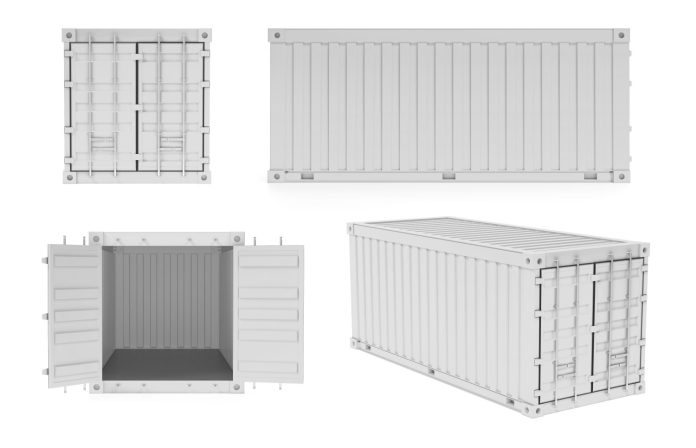If you have ever heard of shipping container storage, you have likely wondered how shipping containers are used and repurposed for storage needs.
While standard shipping containers and those specifically adapted for storage purposes both serve as robust vessels for transporting goods, their functionalities diverge when it comes to storage applications.
In this article, we delve into the distinct features and modifications that differentiate these containers. From structural differences to specialized security measures and interior layouts, we’ll unravel the factors that make storage containers uniquely suited for housing belongings long-term.
Whether you’re considering investing in storage solutions or simply curious about the logistics behind container adaptations, join us as we uncover the key differences between standard shipping containers and their storage-focused counterparts.
What is a Shipping Container?
A shipping container is a standardized, modular steel box primarily used for transporting goods via ships, trains, or trucks. Typically rectangular in shape, these containers come in various sizes, such as 20 feet or 40 feet in length, with standardized dimensions to facilitate efficient handling and stacking.
Equipped with corner castings and twist locks for secure stacking and intermodal transport, shipping containers streamline logistics, reduce shipping costs, and improve overall cargo security. Beyond transportation, these containers have been repurposed for diverse applications such as storage, housing, and construction due to their durability, affordability, and ease of modification.
What Are Shipping Containers Used For?
The most well-known use of shipping containers is for, as the name suggests, shipping and logistics.
However, shipping containers can serve a multitude of purposes beyond transportation.
Shipping containers can be repurposed as storage units for various items, ranging from household goods to storing commercial inventory. These containers can also be adapted into modular housing, providing cost-effective and sustainable living spaces. They can also be used to temporarily store household belongings when you move.
Meanwhile, construction projects utilize containers for temporary structures like offices and classrooms, capitalizing on their mobility and durability. In disaster relief efforts, shipping containers serve as emergency shelters due to their rapid deployment capabilities.
Shipping containers can also be transformed into creative architectural designs such as cafes, art galleries, and pop-up shops, showcasing their versatility in diverse contexts.
Overall, shipping containers play a pivotal role in facilitating storage, housing, construction, and innovative ventures across numerous industries and applications.
What is a Storage Shipping Container?
A shipping container for storage is exactly the same as a standard shipping container, save for a few modifications. These containers typically come in standard sizes like 20 or 40 feet in length, featuring a robust structure with weather-resistant properties.
With secure locking mechanisms and features designed for safe storage, these containers provide a safe and accessible solution for storing various items, from household belongings to commercial inventory.
Customizable options allow for additional features such as shelving, ventilation, and insulation to meet specific storage needs. Utilized in both residential and commercial settings, shipping containers for storage offer a versatile and cost-effective solution for temporary or long-term storage requirements.
The Benefits of Using Shipping Containers for Storage
Using shipping containers for storage offers numerous benefits, such as:
- Physical Durability: The robust steel construction of shipping containers ensures durability and security, protecting stored items from theft, vandalism, and harsh weather conditions.
- Convenient Sizing: Standardized sizes and the stackable design of storage containers maximize space efficiency, allowing for scalable storage solutions. Additionally, shipping containers are portable and easily transportable, facilitating simple relocation to different locations as needed.
- Versatility: Shipping containers are highly versatile and can be adapted to specific storage needs, such as climate control, shelving installations, and specific storage requirements.
- Cost Effective: Repurposing shipping containers for storage is cost-effective compared to traditional building construction, making it a financially sound storage option.
The Difference Between Shipping Containers vs. Storage Shipping Containers
While both types of containers share similar structural elements, shipping containers used specifically for storage purposes often undergo modifications tailored to enhance their functionality in stationary settings.
These modifications may include adding features like insulation, ventilation systems, and interior partitions to optimize storage conditions for various items. Additionally, storage containers may have reinforced flooring to support heavy loads and shelving systems for improved organization.
Security enhancements such as lockboxes and tamper-proof locking mechanisms are also common in storage containers to safeguard stored items.
These adaptations differentiate storage containers from standard shipping containers, which are primarily designed for transportation. While both provide sturdy enclosures, storage containers are tailored to meet the specific needs of stationary storage, offering enhanced security, climate control, and organization features suitable for long-term storage solutions.
Final Thoughts
Standard shipping containers excel in efficient transportation of goods but lack the versatility required for stationary storage needs.
To customize shipping containers for storage purposes, these containers undergo modifications tailored for stationary use. These modifications often include enhanced security, climate control, and organization features suitable for long-term storage solutions.
Understanding these distinctions is vital for selecting the appropriate container type to meet specific storage requirements. Whether for temporary or long-term storage, choosing the right container ensures optimal protection and organization of stored items.
By acknowledging these differences, individuals and businesses alike can make informed decisions when investing in container solutions tailored to their storage needs.







